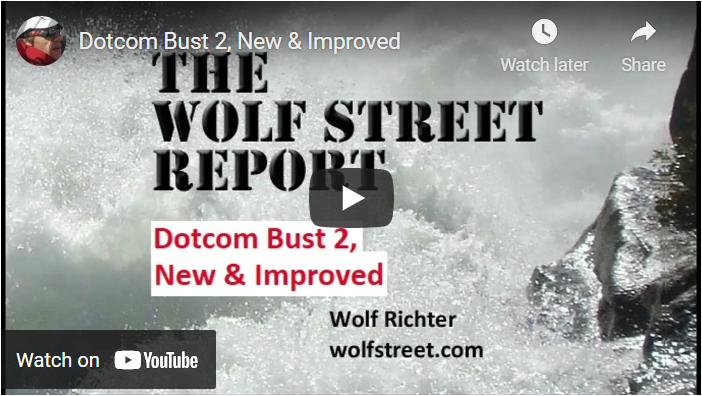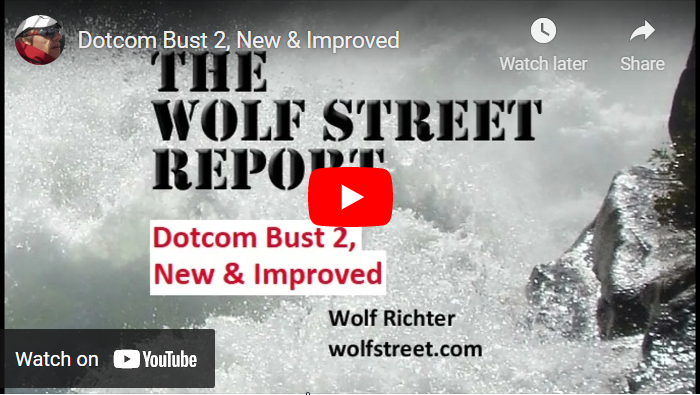
Dotcom Bust 2, New & Improved
But we’ve had it so good for so long. And it was so easy, and it made everyone look like a genius.
By Wolf Richter.
One of the big mysteries in this grotesquely overstimulated economy that the Federal Reserve is now trying to de-stimulate, is the labor force.
The labor force is defined as the people who are either working or who want to work and are actively looking for a job but don’t have a job. The labor force has risen over the past 12 months, but not enough, and has remained stubbornly below pre-pandemic trends, which is contributing to the large-scale so-called “labor shortage,” including an astronomical number of unfilled job openings, with company after company complaining for the past 12 months that they’re having trouble hiring enough people. According to the latest data last week, there were a record astronomical 12 million job openings in April, up by 54% from the pre-pandemic April 2019.
Employers are trying to hire people away from other employers. And workers are job hopping. They’ve discovered that suddenly they have leverage in the labor market and can get better jobs, higher pay, and better working conditions, perhaps even in other industries, where employers are desperate to hire workers.
So there is massive churn in the labor market, with people jumping jobs because compensation packages are better on the other side of the fence, and it is through this mechanism of churn that wage increases have spread throughout the economy, at the steepest rates in four decades, though they’re still not enough to make up for raging inflation.
All kinds of reasons have been cited to explain this mystery of the labor shortage and this huge number of job openings, and all kinds of reasons have been cited why the labor force has refused to go back to the old normal trend.
Some of those reasons have gotten resolved. Others have been debunked, and others have moved from being seen as kind of a joke to being a real issue.
One of those reasons that started out as kind of a joke and has over time become increasingly realistic, goes like this:
The Federal Reserve’s $5-trillion in money printing since March 2020 inflated asset prices across the board, from stocks with the most ridiculous valuations to even more ridiculous cryptos, to such an extent that people took huge risks based on a wing and a prayer, and made hundreds of thousands or millions of dollars in the shortest amount of time, and expected for this to continue, and decided that they would forget about working and just trade miracle stocks and crypto blessings.
And now, all this stuff has started to deflate, and I’m looking for signs that these folks are coming back to work after having gotten wiped out in their leveraged positions. But for now, prices of these assets and gambling tokens don’t seem to have deflated nearly enough, and there is still wide-spread hope that they’ll start spiking all over again.
This theory is not new. Some of us rode to easy riches during the dotcom bubble. At the peak, we were rich and very smart. We were geniuses, practically. The internet was the big thing. Everything with “.com” in its name was instantly worth billions of dollars, and we all knew why. Because this was a new paradigm, and it was different this time.
People who’d been around the block told us that this crap we were investing in was crap, and they told us that taking on margin debt to the hilt to buy more crap was very risky, and they told us that they’re just fine sitting on their Treasury securities and high-grade corporate bonds earning 5% or 6% a year – yes those were the times before all-out interest rate repression.
We ridiculed them for not understanding the new paradigm, and for not understanding that it was different this time. And how could they be satisfied with returns of 5% to 6% when we were doubling our money in just a few months?
I’m not sure how many people became professional day traders. I knew a few. As for me, at least I traveled around the world for three years without coming home, to over 100 countries on all continents, starting in early 1996, an immeasurably wonderful experience. Those three years of traveling were funded by the dotcom bubble, by the inflating value of my portfolio. While I was traveling, I wasn’t even trading. It just kept inflating.
Then I came back, and not much later, crap turned into crap, and our wealth got mostly wiped out when the Nasdaq crashed 78% between March 2000 and October 2002.
Over this period of two-and-a-half years, the Nasdaq crashed from a little over 5,000 to about 1,100 – and it did so despite a vicious 35% bear-market rally in the summer of 2000 that drew more people into stocks, before wiping them out too, and hundreds of companies shut down, and their stocks crashed to zero and died.
There was no recovery for those stocks. There were delisted and removed from the indexes before they hit zero, so that they wouldn’t drag down the indexes further, and that was it for them.
On October 9, 2002, the Nasdaq, at 1,114, was back where it had first been in April 1996, six years earlier.
We now only remember the survivors and the few big winners to come out of this, such as Amazon.com. But it was brutal. Our lives were being crushed on a daily basis. And every rally turned into just another set of fake hopes. And eventually, we went back to work.
Then stocks – the survivors and some new ones, such as Google – started rising again. In October 2007, as the Financial Crisis was starting to seep to the surface, the Nasdaq had just breached 2,800, before wandering lower and then crashing. In March 2009, it hit 1,268, back where it had first been in May 1996. A wild ride to nowhere that lasted 13 years. In other words, it had unwound 13 years of gains.
And what happened then? A historic money-printing binge to bail out the banks at first, and then to bail out the housing market, meaning the mortgage market, and then to accomplish the wealth effect, pure and simple, which drove the Nasdaq to the ridiculous high of 16,212 by November 2021.
So now, the money printing has ended, rates are going higher, and the Nasdaq has dropped to 12,000 on Friday, down 26% from the high. So that’s not a big decline.
But many individual highflying stocks are down over 80% or 90%. Some of the biggest cryptos are down over 50% from their highs. There are over 10,000 cryptos. Many are down nearly 100%. Tons of them appear to have died.
And folks heavily concentrated in these kinds of bets, and leveraged, have already lost a big part or all of their gains, or even all of their capital at risk.
This time around, people who are betting on the Federal Reserve to bail out the markets with rate cuts and money-printing are facing a complication in their calculus:
The Fed won’t cut rates or restart its money printing binge – it will instead hike rates and shed assets, meaning the opposite of money-printing – because the biggest problem the US economy now faces is raging inflation that has spread to services.
In services, inflation is shooting higher, even as some goods prices are flattening out, and services is where consumers spend 70% of their money, and this inflation in services is now spiking, and is in the process of turning into runaway inflation, and the Fed is going to try to prevent this inflation from tearing up the economy, and it’s cracking down, and it’s not going to bail out stock prices or crypto prices, and it’s specifically targeting the real estate bubble due to its contribution to inflation via the housing cost components in the Consumer Price Index.
Those over-inflated asset prices cannot suddenly stand on their own two feet after having been driven to these highs by money-printing and interest rate repression since late 2008. So it’s going to be rough out there.
But we’ve had it so good for so long. And it was so easy, and it made everyone look like a genius. Look at the long-term chart. Since early 2009, when the money printing and interest rate repression started taking effect, asset prices have spiked out the wazoo. And folks sitting on assets have gotten immensely rich via the asset price inflation that the Fed had engineered. The more they had, the richer they got. And it has created the biggest wealth disparity in the US ever between to top 1% and everyone else.
This is according to the Federal Reserve’s own data on wealth distribution that I depict in my “Wealth Disparity Monitor.” You can google that: wealth disparity monitor, and it comes right up at the top.
So now, that asset price inflation has turned into consumer price inflation and wage inflation that the Fed is fighting, it’s time to give up some of those gains.
And no, we cannot get out all at the same time because if we tried to get out all at the same time, the whole thing would just collapse.
Look at this way, a 40% decline in the S&P 500 would just take us back three years, to June 2019. Unwinding three years of gains is nothing. This happened many times before. And it’s no biggie.
By the time the S&P 500 bottomed out in March 2009, it had unwound all the gains since 1996. It had unwound 13 years of gains. The Nasdaq had also unwound 13 years of gains.
Just to give you a for-instance to think about: If the S&P 500 index drops 70% from the January high, which would be a huge massive drop, it would only wipe out the gains of the past 10 years. This is how crazy the stock price inflation had been over the past decade.
What happened during the dotcom bust was that plenty of people who were invested in individual stocks, and had bought some of them on margin, they got margin calls and they had to sell their shares, their most liquid shares that could be sold, and they might have sold Amazon, and they got cleaned out, and for them, when stocks bounced, there was essentially no recovery, because they couldn’t participate because their money was gone and their Amazon shares were gone, along with all the shares that had died.
And during the dotcom bust, folks that were loaded up with the high fliers that then went to zero or near zero, even if those folks weren’t margined, they lost a lot more than the 78% decline of the Nasdaq. And they then had to just start all over again.
This money-printing orgy and interest-rate repression that started in late 2008 has created a far bigger and wider asset price bubble than the dotcom bubble. This time around, it’s stocks, it’s bonds, it’s real estate, and now they’re also cryptos to lose all your money with.
The opportunities to get wiped out are much greater now. But hey, no biggie. Investors had it so good for so long. But that ride cannot go on forever. And we’ve been through this before. And at some point, lots of people will come back from their long travels, and others will mothball their trading rigs, and others will say goodbye to what’s left of their cryptos, and they’ll start looking for jobs again. But we’re not anywhere near that point yet.
From wolfstreet.com
